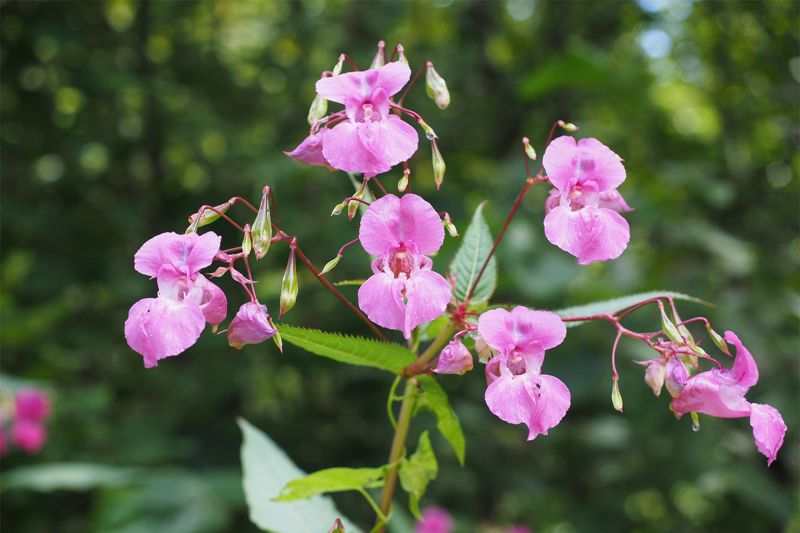Wales is no stranger to Himalayan balsam, and nor are we! Our team has tackled this invasive species many times over the years. So, what is the best removal method?

Tackling Himalayan balsam in Wales
Himalayan balsam in Wales was recently written about on nation.cymru. Penned by ecologist Tawny Clark, the article was fun and informative and we thoroughly enjoyed it!However, we do have our two-pence to add. In this post, we'll discuss what Himalayan Balsam looks like, biodiversity issue, and most importantly, how best to remove it.
What does Himalayan balsam look like?
Himalayan balsam is a weed. It grows between two and three metres tall, towering above other invasive species, such as Japanese knotweed, and can skyrocket past sunflowers.
Anytime between early summer and mid-autumn, Himalayan balsam will produce pink/purple flowers shaped like a helmet. It’s no wonder this weed is also called policeman’s helmet and gnome’s hatstand in the UK!
And that’s not the only fun fact about Himalayan balsam, because we haven’t even mentioned how it bangs. That’s right – Himalayan balsam explodes. Specifically, the plant produces seed pods which explode when the plant is matured, and with only the slightest encouragement. In fact, simply touching one of the pods will make it pop!

Why is Himalayan balsam a problem?
Like other invasive species, Himalayan balsam encourages riverbanks to erode during winter fallback and can exacerbate flooding. However, the real problem is with biodiversity.
Himalayan balsam battles with Wales’ native plants for sunlight, pollinators, nutrients and territory. By doing so, it stops our plants growing and reduces variety. Sadly, the sheer amount of it now growing in the UK is alarming. After all, it’s so easy for Himalayan balsam to reproduce. Not only does it produce a huge number of seeds, but can send those seeds around two metres in any direction. According to gardenorganic.org.uk, Himalayan balsam “spreads at the rate of 645km2 per year in the UK.”
So, how do you go about tackling such a monster?
What is the best method for Himalayan balsam removal?
It’s always best to remove Himalayan balsam before it seeds. As Tawny Clark identifies...“we need to act quickly before [the seeds] appear.”
However, we do have to disagree with the writer’s favourite method to remove the plant with what she calls ‘balsam bashing’. We’re not trying to bash Clark’s well-meaning efforts and community spirit to get rid of the invasive weed. But, it’s well-known in the invasive weed industry that ‘balsam bashing’ is not an effective removal methods and can, in fact, make the plant spread further.
There are two main, recognised Himalayan balsam removal methods.
- Pulling/mechanical – the best method for smaller, sporadic plants where the weed is pulled up well before it flowers no later than early summer.
- Herbicide treatment – where Himalayan balsam is treated with herbicides over a period (usually two or three years) and consequently monitored for regrowth.
The size, age and location all play a part in determining the best removal method for Himalayan balsam. Remember, the slightest of touches can send this pesky plant exploding in all directions.
Himalayan balsam and UK law
Here's what you need to know about this invasive weed and UK law:
- The size, age and location all play a part in determining the best removal method for Himalayan balsam. Remember, the slightest of touches can send this pesky plant exploding in all directions.
- It is illegal to cause Himalayan balsam to grow in the wild (Wildlife and Countryside Act, 1981).
- Depositing, treating, keeping or disposing of Himalayan balsam without a license is an offence (Environmental Protection Act 1990, Section 33).
- Failing to control Himalayan balsam on your land can land you with an ASBO!
If you are found guilty of any of these offences, you could be slapped with a £100 on-the-spot fine. Or, as a individual, you may have to pay £2,500 or £20,000 if you’re a business.
Conclusion
All in all, we enjoyed Tawny Clark’s article, but if you do have a infestation on your hands, we don’t suggest tackling it yourself! Find out how our effective, affordable removal plans for Himalayan balsam can help you. Contact our Cardiff team today.